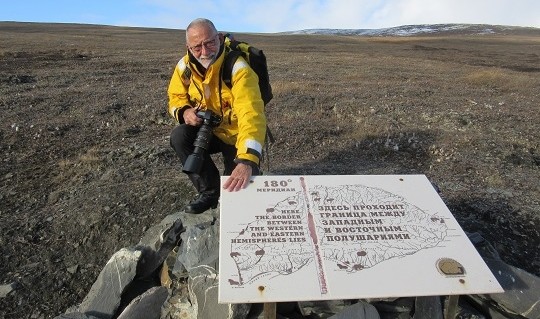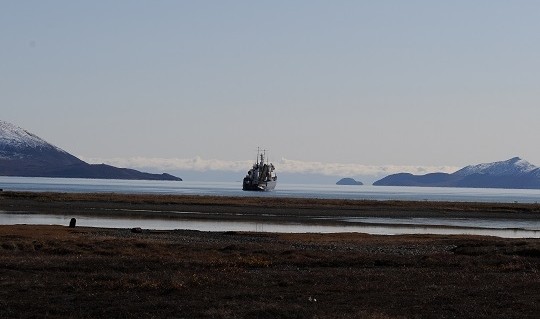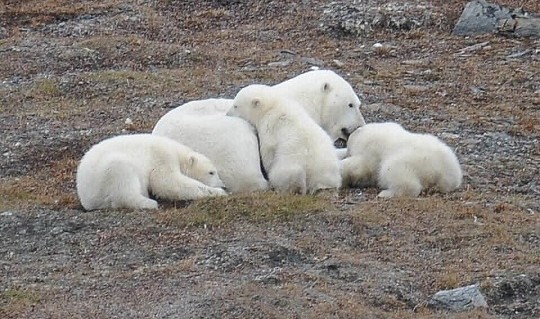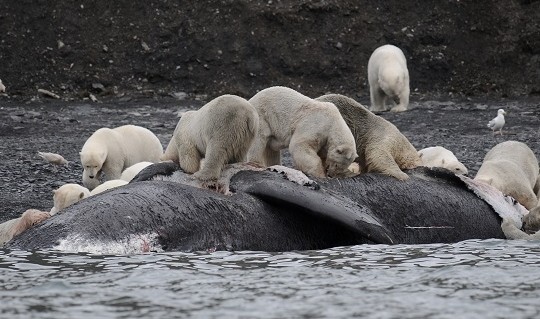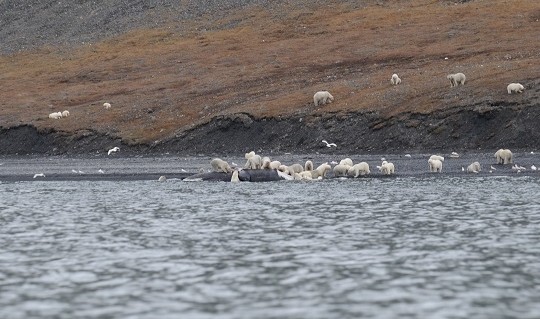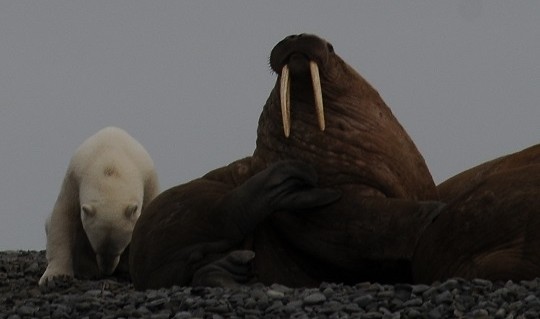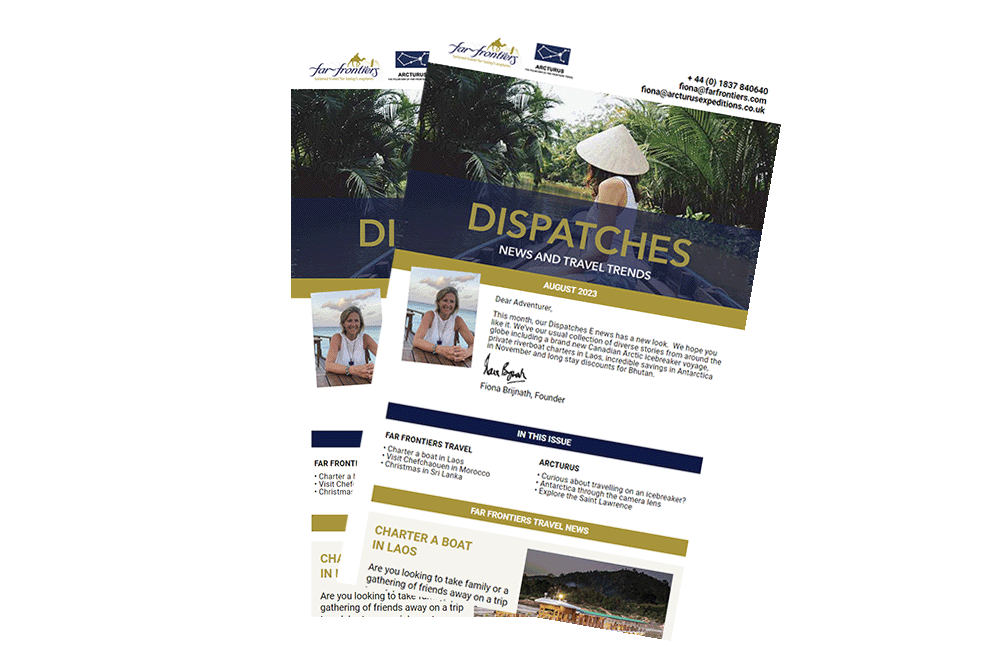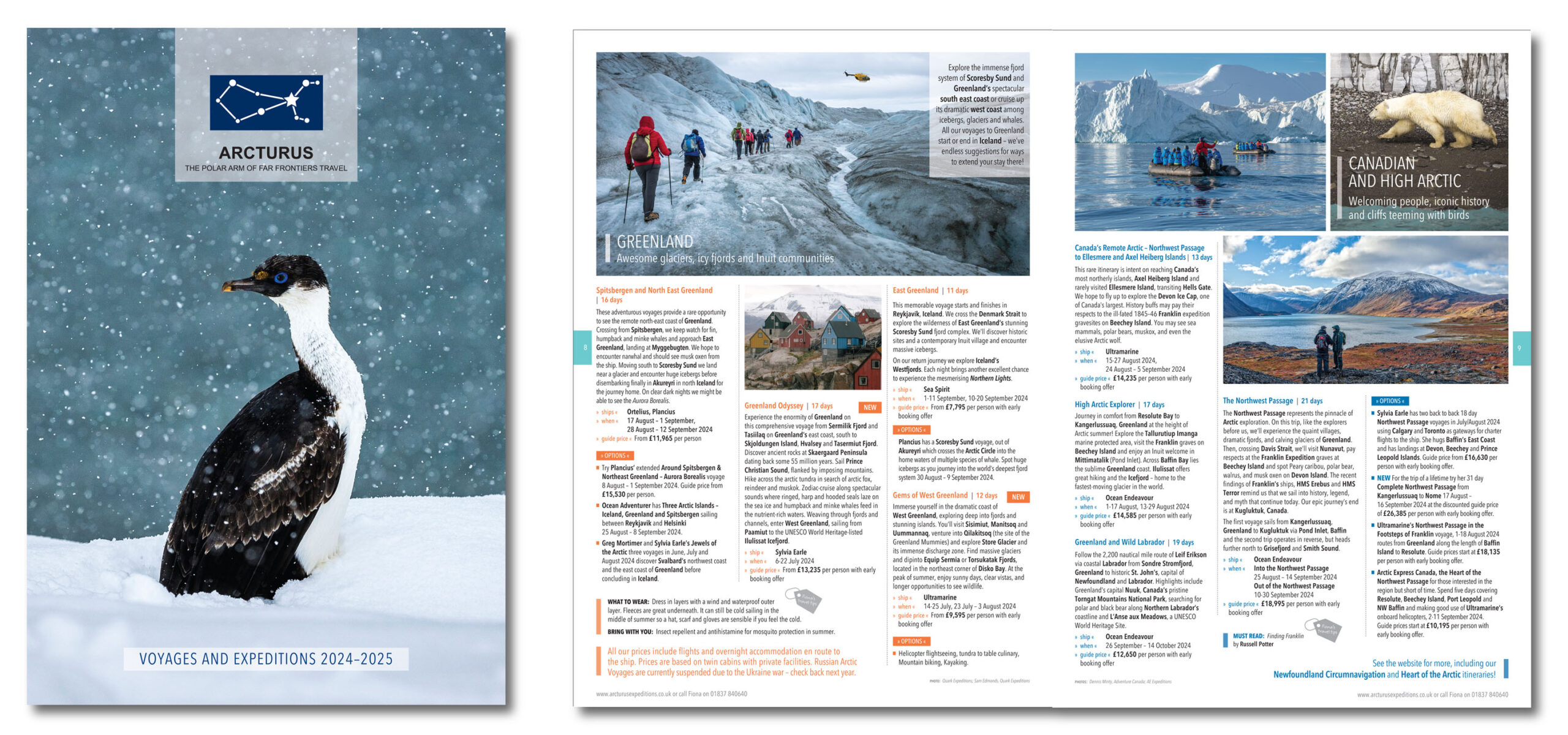Client Report: The Northern Sea Route and Wrangel Island – Peter Wright’s chance in a million encounters with polar bears
Peter Wright’s voyage of the Northern Sea Route and Wrangel Island with Arcturus took him to parts of the Arctic seen by very few people. He witnessed both the vastness of this fragile part of the Arctic and the challenges it faces due to human activities. His extraordinary sightings of polar bears were so rare they are unlikely to have ever been witnessed before.
28 August – 26 September 2017
“Once again, I am indebted to the organisation and personal attention to detail, most notably on the part of Fiona, for making this transit of the Northern Sea Route (North East Passage) a reality. Some years ago I had hoped to sail from east to west; but the voyage was stopped by the Russian authorities at the last minute.
My greatest memory of this latest voyage will always be seeing a gathering of polar bears on Wrangel Island feasting on a bowhead whale that had washed ashore at Cape Thomas. I was later told that the number was more than 180, with around 50 more on their way to join them! Among these bears was a mother with three cubs, maybe even four, a truly once in a lifetime sight.
Our journey started with an early flight from London to Moscow (and the first of many more visa and passport checks). Upon arrival in Moscow, a guide ensured we got to the right airport for the onward journey to Murmansk. We finally arrived at the hotel at 0430 – a long day. We were able to walk about a little in central Murmansk in the morning before transport to join the Akademik Shokalskiy at the commercial port, sailing later that evening out of the Kola Bay to the Barents Sea and setting course to Franz Josef Land.
The first day and a half was a little ‘bumpy’ but the sea swell was on the quarter, so not so bad. First stop was Tikhaya Bay (Hooker Island) to pick up the park rangers who would look after us. Tikhaya Bay Polar Station has been ‘cleaned up’ since my last visit in 2015, a great effort by the Park Service. The next two days we made visits to and landings (when possible) on various Islands: Champ Island (spherical geodes), Bell and Northbrook Islands (historical sites), Hall Island (Cape Tegetthoff), Heiss Island (Atlantic walrus haul out). Northbrook was called off because of a heavy swell on the steep rocky shore – two of the staff had a cold early bath!
We then sailed to Alexander Land to land our Russian guests, followed by a full inspection of passports and visas by the Border Guard service (RBG). Once completed, we sailed for the Kara Sea and Severnaya Zemlya. Miles and miles of nothing, so a good chance to get to know some of the other passengers. One of the things I enjoy on these small ships is meeting people from so many different countries and backgrounds.
Arrived off Golomyannyi Island (Severnaya Zemlya) and anchored, followed by a wait for clearance to land (RBG). Restricted to a small area by a meteorological station (the first of many we visited), then made passage to Domashmy Island to see a colony of ivory gulls. The plan was to pass between Pioneer Island and October Revolution Island via the Krasnoy Armu Strait but, just after midnight, the ship had to reverse course as the ice became too heavy (Akademik Shokalskiy is an ice strengthened RMRS Ice Class UL) not an icebreaker. Overnight passage saw us in the Shokalskiy Strait on course for Marata Fjord with its high cliffs and glaciers.
Anchored at the head of the fjord we had the first chance to stretch our legs. Most flora is over at this time of the year – we saw a few birds and tracks of a fox. Surprised and disappointed by the amount of plastic rubbish to be found on the foreshore. Weighed anchor setting course for Tilmana Fjord on Bolshvik Island and another walk and zodiac cruise. By the end of the day on course to Cape Chelyusskin (most northern point of the Eurasian mainland). OK with the RBG for the cruise but not to land, being a military area. At the Cape the weather was not at its best. Windy, snowy and an unpleasant swell which caused camera problems for some in the zodiacs – salt water in the works!! Not a lot to see apart from hundreds of old rusty 180 litre drums scattering the area. We were to see thousands of them almost everywhere, along with rusting vehicles during our voyage – many of the island areas we visited are part of one big scrap yard.
From the Cape we set course for Malyi Taymyr (an abandoned weather/polar station) and to Pronchischevoy Bay (Bukhta Marii). Here another station and a chance for a tundra walk (long, medium or short beach walk). At the entrance to the bay is a shingle spit used by the Laptev walrus as a haul out. We watched a young polar bear seemingly thinking about taking on a walrus but, upon seeing the size of the big bull, deciding it was not such a good idea. We left the bear sitting close to the haul out watching younger walrus coming ashore. A remarkable sight. From here across the Laptev Sea to the New Siberian Islands (Stolbovoy, Little Lyakhovsky, Great Lyakhovsky and Kotelny islands). On Great Lyakhovsky we met the three men and one lady who staff the active weather/polar station. Their ‘deep freeze’ is a cave dug (by hand) some six to eight metres below ground level into the permafrost. I understood they would be at the station for two years! On to Kotelny Island through the Dmitry Laptev Strait as the Sannikov Strait was closed (by the Military). Ice had been expected in the strait but there was none to be seen.
After an overnight passage, we arrived at the anchorage off Zemlya Bunge Polar Station. Two stations in fact, the original (single timber cabin) separated from the main (now abandoned) station. From here, the start of a 36 hour passage to Medvezhyi Islands through the East Siberian Sea and the highlight of the day – a second ship since Murmansk. We found a suitable anchorage off Pushkaryova in the early hours of the morning. From the bridge, first one bear was spotted, and quickly another. Within a very short space of time, there were seven bears and cubs on the cliffs and foreshore. A landing was made in a ‘safe’ area for an hour or so before returning to the ship for breakfast and passage to Chetyryokhstobovoy Island (Four Pillars Island) anchoring off another abandoned station. Sadly the landings had to be cancelled as at least one large male bear was ‘at home’ in a station building and a few more at the Pillars. So, in order not to stress the bears (or indeed the passengers) it was decided to make a Zodiac cruise. We had a wonderful meeting with a mother and two cubs on a low cliff not more than 50 – 80 metres from the Zodiac. They all seemed totally relaxed and unfazed by our presence. After a while, the bears just walked back to the tundra. We continued along the coast (more bears) finally landing in a bear-free sheltered bay. The total bear count for the day was 15 to 20 plus five cubs. To date, I had never seen so many bears in one day before. However, that was to change a few days later.
Our visit to Ayon Island had been cancelled for permit reasons, so our next stop was Wrangel Island, arriving at the anchorage in Krasin Bay at around 0400. Later in the morning, a landing was made (wet, very wet) to meet the State Park rangers who would be with us for our time in the area followed by a short walk around Zvezdnyi and the surrounding tundra (Arctic fox, musk ox and snowy owls). After a wet and bumpy Zodiac trip back to the ship, we weighed anchor and proceeded to Devils Creek, the 180° meridian passes through this landing site. Another chance for a tundra walk up to a ridge overlooking Mammoth River which reminded me of the Scottish Highlands in winter – except for wolf and bear tracks in the snow!! Once back on board, we set sail for overnight passage to the east side of the island, Clark River and Drangi Bay. At Clark River we waited for one large bear to finish his morning stroll on the beach for an hour or so, and then it was judged ‘safe’ to land. A great sunny day and an enjoyable walk during which we came across an endangered Wrangel lemming enjoying the sun, an uncommon sight. On the way back, we had a ‘standoff’ with an over-inquisitive bear on the other side of the river, but, after a time – with both sides watching each other – it lost interest and walked off up river away from us. On the passage up to Drangi Bay we had the magnificent sight of a grey whale breaking surface just ahead of the ship, straining the silt from its feed off the seabed. Drangi Bay is the site of the Karlu(c)k memorial stone for the crew of the ‘Karluc’ who made camp there in March 1914 after the ship was crushed by ice). From the bay we made a Zodiac cruise to one of the largest Pacific walrus haul outs. Although some distance off the haul out, the grunting was tremendous as it echoed off the cliffs. Walrus everywhere – hundreds, maybe thousands, on the shore and in the waters nearby. A couple of times our Zodiac was ‘bumped’by the odd surfacing walrus. We also saw couple of whales blowing and diving – a nice end to a special day.
Overnight we continued northwards and around to the west coast and Lake Kmo for an early morning landing. This time, it was the beach walkers who experienced an obnoxious young bear that would not take no for an answer and, for the first and only time, a non-lethal deterrent had to be used. The next planned anchorage was the Ranger Station to drop off two of our guides. As we came to Cape Thomas, we were greeted by an incredible sight: The hillside and foreshore were covered with white dots – bears – male, female and females with cubs. On getting closer, one could see the main attraction was a large dead whale washed ashore. We anchored and took to the Zodiacs in order to get a closer look at this unusual spectacle. From my photos I have counted at least 150 bears. Reports have varied from 180 to over 200. It is an experience I will never forget and very much doubt many others would see again. We were also told it is rare to see a female bear with three cubs but very rare indeed to see four. An absolutely astounding experience. Sadly it was time to leave as more bears were arriving to join the party.
Next we set course across the Chukchi Sea towards Kolyuchin Island, Uelen Village and Cape Dezhnev. Our landing on Kolyuchin was delayed because of a polar bear, who eventually went for a swim! Landings the next day on Uelen and Cape Dezhnev had to be cancelled due to marginal landing conditions so we made a back-up visit to Lavrentiya, some four hours down the coast. Lavrentiya was founded around 1927 and is now the admin centre for the Chukotsky District. The visit was very much under control of the RBG. We were only allowed to the village centre, museum and an area where locals presented a series of dances and food (berries, pickles and whale (?)). An overnight passage found us in the Strait of Senyavina in the early hours, making way to Gil´miml Bay. Once ashore the chance to take one of two walks, either about two hours over the tundra or a shorter walk to the hot springs where there is a concrete bath for soaking in the warm waters followed by a dip in the (cold!) river! In the afternoon, our guide took a group on an 8km+ walk across the island while the ship moved to Bukhta Penkingney, spotting grey humpback and minke whales en route. We anchored in a small bay for the night, getting underway at just before 0345, passing back down Penkingney to Senyavina and, after around four hours, anchored off Itygran Island (Whalebone Alley). The reason for the bones on the island is unclear, but the site dates from the 14th century. It is home to the Northern pika, a small mammal and a close cousin of the rabbit. As the conditions were good, we boarded the Zodiacs for a whale spotting cruise and were able to get close to these magnificent creatures before resuming our passage to Anadyr.
After another night and the following day at sea we arrived late evening at the pilot anchorage to wait to take the pilot on board in the morning. Time to pack up, pay our dues and think back on all those incredible memories from our 28/29 days”.
“THANK YOU Fiona very much for putting together yet another wonderful trip to the Arctic again for me, including all the hard work put in by the staff to make this ‘adventure’ such a success. The memories from this trip will stay with me for a very long time to come. They have surpassed many from my previous visits to this part of the world.”
Peter Wright September 2017
All photographs courtesy of Peter Wright

